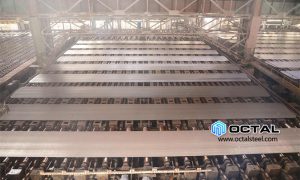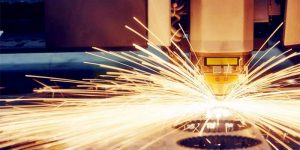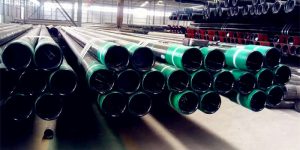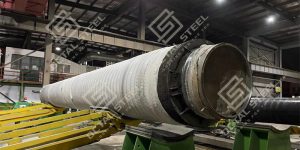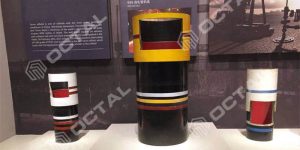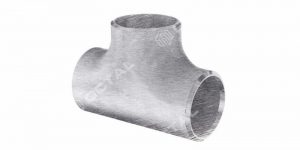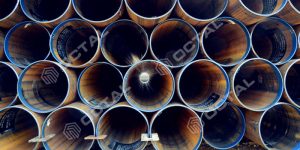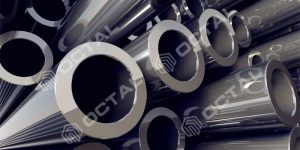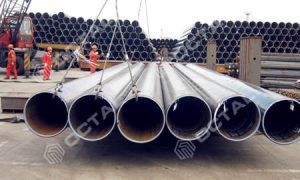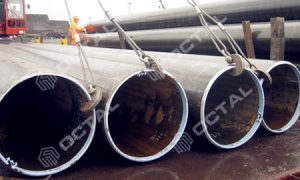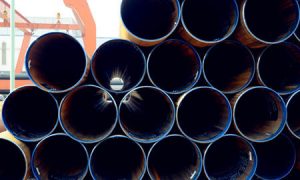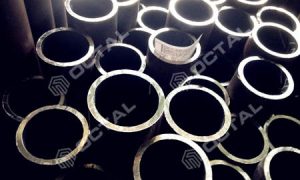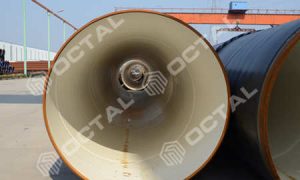Flame Cutting (Oxy Fuel Cutting) – A Method to Cut Steel
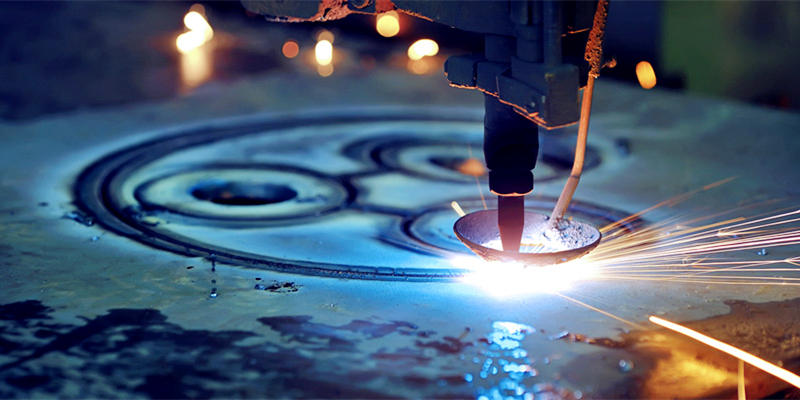
Flame cutting (also known as oxy fuel cutting), it is to use the heat burned from oxy fuel gas, to cut steel materials or the hard metals to the panels or profiles required. It can cut steel thickness from 1 mm to 1200 mm. And in most cases it used to cut steel plate thickness more than 20 mm, since oxy fuel cutting usually brings big tolerance. For steels under 20 mm, better to use other cutting method like laser cut or waterjet cut. (For to get a high precision.)
On the other hand, as oxy fuel cutting technology is developed nowadays, with a proper oxy fuel gas mixture and good temperature control, also we could get a high precision flame cutting (a quality flame cutting). Especially with CNC flame cutting technology integrated in, it has been widely used in steel parts manufacturing processes.
What is Flame Cutting or Oxy Fuel cutting
Flame cutting (oxy fuel cutting or oxy acetylene cutting), as it’s name, with oxy fuel gas burning through a cutting torch, makes a flame and with the flame heat to cut steels. It is an oldest way in hot steel cutting activities. The cutting torch is designed to provide Oxygen fuel gas for to burn the iron oxide, in this way to guarantee the stable of the temperature and get better cutting performances.
Why flame cut steel used much in cutting steels
Flame cut steel is an old and very common cutting steel technology for cutting steels. As we know, metal fabrication entails cutting, heating and welding steel. There are numerous techniques used to shape steel, flame cut steel is one of these techniques and with hardware development now you are able to get a quality flame cutting steel parts. It entails the use of fuel gas and oxygen to cut shapes from the steel plate. This technique is gaining widespread popularity for various reasons.
Here are some of the reasons and advantages:
• Lower cost and lower investment (Flame cutting machine is cheaper than Laser cut or waterjet machine. Even with a oxy fuel cutting revolver you can do the cuts.)
• The only way to cut steel with big thickness (to cut thick steel).
• It is relatively affordable when compared to other techniques.
• It can cut through a large metal surface area. This thickness ranges from 1 millimeter to 1000 millimeters.
• This process is portable. It can be used in different locations, apart from a physical workshop.
• CNC flame cutting technology integrated
Disadvantages
• Cutting parts in bigger transformations (Because of the heat melting will makes larger cutting material)
• Operators should have highly skills and much experiences (To get a better precision size and avoid more hot transformation)
How does flame cut steel plate (oxy fuel cut) process work?
Ever asked yourself the above question? If yes, you are at the right place. The flame cutting steel plate process is thermo-chemical. This process requires intense heat commonly referred to pure oxygen. This oxygen fuel can be found in bulk systems and cylinders. Non pure oxygen reduces the cutting speed of steel. Consequently, pure oxygen fuel can mix with impurities through leaks, bad hoses and improper connections. Pure oxygen fuel should be carefully used or it risks serious injuries.
Cutting materials types
The flame cutting steel process can be use for numerous purposes, provided the oxide formed has a low melting point when compared to the material being cut. This is the reason the oxy fuel cutting process cannot be used with other materials. A perfect example is aluminum.
Flame Cutting (oxy fuel cutting) Types
Flame cutting types mainly divided in torch cutting and CNC flame cutting (machine flame cutting table).
Flame torch cutting
Flame torch also called fire gun. With different gas, the torch has different structural. Most used is Oxygen-Acetylene gas torch, acetylene pressure at 0.01 to 0.12 Mpa, Oxygen pressure 0.50 to 1.0 Mpa. Two different gas burned in it’s own channel and mixed together in oxy fuel cutting torch, the flame could be adjusted manually. This type of oxygen cutting mainly used to re-cutting to remove the defects from the steel billet cutting or steel straightening.
CNC flame cutting for steels
CNC flame cutting is processed by CNC cutting machine, that is to use CNC technology to drive the flame cutting table and cutting torch, to cut steel plate, steel sheet and other metal materials. CNC flame cutting equipment integrated the machine, table, electricity, and flame torch. So it includes three big part: CNC control systems, flame cutting systems, and drive systems.
CNC flame cut steel advantages is it can cut big thick steel plate, lower cost, but disadvantages also the same with common flame cut. Which is big transformation, lower precision, slow cutting speed takes long time for preheating, perforation slow, and is hard for all the auto operations. So it’s application limited to carbon steel, and thick steel plate cutting. For the thin steel plate cutting under 20 mm, it is almost substitute by laser cut, or plasma cutting technical.
How can the flame cutting performances could be enhanced?
There are two factors which influence the performance of the flame cutting process, namely the nozzle selection and the fuel type. These two factors can increase or reduce both the labor cost and the cutting speed. In addition to this, the oxy fuel jet and the gas used influence the cutting period used to cut through a material. In most cases, oxygen fuel is mixed with other fuel gas such as propane, methane; acetylene, propylene and MAPP to reach achieve the ignition temperature. The flame cutting steel temperature must below the material’s melting point. Afterwards, pure oxy fuel is passed through the preheated area to kick off the flame cutting process.
The chosen ignition gas depends on whether the process is mechanized or manually handled, the material type and the work being handled. A gas is not suitable for use if doesn’t generate the required heat or if it exceeds your set budget.
Flame cutting thickness range for steel plate
This is among the commonly asked questions when people are inquiring about the flame cutting process to cut steel plate or steel panels. As earlier stated, this process can be traced way back when industrialization was at peak. It is proven that this process cuts up to 100 inch material. It is evident this process simplifies material cutting task.
All thin material must be intensely preheated to enhance the cutting speed. Additionally, the preheating process improves the cutting process. This preheating process remains constant for all thick materials.
The point is, The thickness of the steel being cut depends on the amount of oxy fuel being delivered during the cutting process. The fuel gas and pure oxygen can be adjusted to deliver smooth cut surface, depending on a person’s needs.
Cutting temperatures
Generally the preheating process entails heating a material between 1600-1800 degrees F.
Secondly, pure oxygen is passed through the heated area to facilitate burning or oxidization. This is the reason a person can achieve an excellent final cut surface. It can be a sharp slag-free lower edge, sharp top edge or a flat cut surface.
How to get a quality flame cut steel panel with higher precision?
There are numerous factors that control the flame cutting process, so to get a quality flame cut steel panels or parts with higher precision. There are some factors we shall be noted:
• Carefully studying and understanding the working process. It is advisable to hire a professional service provider if you find this process difficult or stressful.
• Selecting a perfect tip for achieving your desired cuts. There are numerous tips people can use to achieve their desired results. Selecting a simple technique makes it easy to achieve your desired outcome.
• Choosing the correct oxy fuel cutting pressure. People have different needs. Choosing the correct oxygen pressure ensures you achieve your desired quality cut.
• Taking the preheating process seriously. Some people take this process lightly. The preheating process determines if the entire flame cutting process will be a success or not.
• Using the right cutting speed to achieve your desired goals within the set time frame.
There is no doubt the it can help people cut various materials into different shapes at a pocket friendly price. We shall note that not everyone attains a high quality or desired precision flame cutting parts, but with above notes at least you will not get a failed cuts.
Octal providing steel cutting services for different steel materials with different thickness, to cut to the steel panels or profiles needed. If you have this requirement, just let us know.







